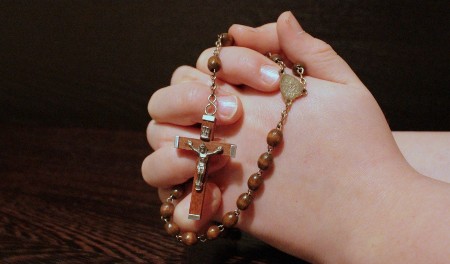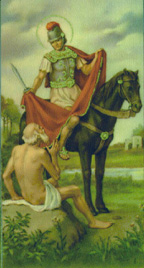Beard
FREE Catholic Classes
Among the Jews, as among most Oriental peoples, the beard was especially cherished as a symbol of virility; to cut off another man's beard was an outrage ( 2 Samuel 10:4 ); to shave or to pluck one's own beard was a sign of mourning ( Jeremiah 41:5 ; 48:37 ); to allow the beard to be defiled constituted a presumption of madness ( 1 Samuel 21:13 ). Certain ceremonial cuttings of the beard which probably imitated pagan superstition were strictly forbidden ( Leviticus 14:9 ). These usages which we learn from the Bible are confirmed by the testimony of monuments, both Egyptian and Assyrian, in which the Jews are invariably depicted as bearded. The Egyptians themselves commonly shaved, and we are told that Joseph, on being taken from his prison, was made to shave before appearing in the presence of the king ( Genesis 41:14 ).
Similarly in Greece and in Rome, shortly before the time of Christ, it was the fashion to shave, but from the accession of Hadrian onwards, as we may see from the existing statues of the Roman emperors, beards once more became the order of the day. With regard to the Christian clergy, no clear evidence is available for the early centuries. The Apostles, in our most ancient monuments, are for the most part represented as bearded, but not uniformly so. (See Weiss-Liebersdorff, Christus- und Apostelbilder, Freiburg, 1902.) St. Jerome seems to censure the practice of wearing long beards, but no very definite conclusion can be drawn from his allusions or from those of his contemporary, St. Augustine. The positive legislation on the subject for clerics appears to be Canon 44 of the so-called Fourth of Carthage, which in reality represents the synodal decrees of some council in Southern Gaul in the time of St. Cæsarius of Arles (c. 503). There it enjoined that a cleric is to allow neither hair nor beard to grow freely ( Clericus nec comam nutriat nec barbam ) though this prohibition is very probably directed only against beards of excessive length. Still this canon, which was widely quoted and is included in the "Corpus juris" had great influence in creating a precedent. (See for example the "Penitential" of Halitgar and the so-called "Excerptions" attributed to Egbert of York.) So far as concerns England in particular it was certainly regarded throughout the Middle Ages as uncanonical to allow the beard to grow. A cleric was known as a shorn man ( bescoren man , Laws of Wihtred, A.D. 96), and if it should seem that this might refer to the tonsure, we have a law of King Alfred : "If a man shave off another's beard let him make amends with twenty shillings. If he bind him first and then shave him like a priest ( hine to preoste bescire ) let him make amends with sixty shillings." And under Edgar we find the canon: "Let no man in holy orders conceal his tonsure, nor let himself be misshaven nor keep his beard for any time, if he will have God's blessing and St. Peter's and ours." A similar practice obtained generally throughout the West and it was one of the great subjects of reproach on the part of the Greek Church, from the time of Photius onwards, that the Roman clergy systematically cut off their beards. But as Ratramnus of Corbie protested, it was foolish to make an outcry about a matter which concerned salvation so little as this barbæ detonsio aut conservatio.
The legislation requiring the beard to be shaved seems to have remained in force throughout the Middle Ages . Thus an ordinance of the Council of Toulouse, in 1119, threatened with excommunication the clerics who "like a layman allowed hair and beard to grow", and Pope Alexander III ordained that clerics who nourished their hair and beard were to be shorn by their archdeacon, by force if necessary. This last decree was incorporated in the text of the canon law (Decretals of Gregory IX, III, tit. i, cap. vii). Durandus, finding mystical reasons for everything, according to his wont, tells us that "length of hair is symbolical of the multitude of sins. Hence clerics are directed to shave their beards; for the cutting of the hair of the beard, which is said to be nourished by the superfluous humours of the stomach, denotes that we ought to cut away the vices and sins which are a superfluous growth in us. Hence we shave our beards that we may seem purified by innocence and humility and that we may be like the angels who remain always in the bloom of youth." (Rationale, II, lib. XXXII.)
In spite of this, the phrase barbam nutrire which was classical in the matter, and was still used by the Fifth Council of Lateran (1512), always remained somewhat ambiguous. Consequently usage in the sixteenth century began to interpret the prohibition as not inconsistent with a short beard. There are still many ordinances of episcopal synods which deal with the subject, but the point upon which stress is laid is that the clergy "should not seem to be aping the fashions of military folk" or wearing flowing beards like goats ( hircorum et caprarum more ), or allowing the hair on their upper lip to impede their drinking of the chalice. This last has always been accounted a solid reason in favour of the practice of shaving. To judge by the portraits of the popes, it was with Clement VII (1523) that a distinct beard began to be worn, and many among his successors, for example Paul III, allowed the beard to grow to considerable length. St. Charles Borromeo attempted to check the spread of the new fashion, and in 1576 he addressed to his clergy a pastoral "De barbâ radendâ" exhorting them to observe the canons. Still, though the length of clerical beards decreased during the seventeenth century, it was not until its close that the example of the French court and the influence of Cardinal Orsini, Archbishop of Beneventum, contributed to bring about a return to the earlier usage. For the last 200 years there has been no change, and an attempt made by some of the clergy of Bavaria in 1865 to introduce the wearing of beards was rebuked by the Holy See.
As already noted, in Eastern lands a smooth face carries with it the suggestion of effeminacy. For this reason the clergy, whether Catholic or Schismatic, of the Oriental churches have always worn their beards. The same consideration, together with a regard for practical difficulties, has influenced the Roman authorities in according a similar privilege to missionaries, not only in the East but in other barbarous countries where the conveniences of civilization cannot be found. In the case of religious orders like the Capuchins and the Camaldolese Hermits the wearing of a beard is prescribed in their constitutions as a mark of austerity and penance. Individual priests who for medical or other reasons desire to exempt themselves from the law require the permission of their bishop.
Join the Movement
When you sign up below, you don't just join an email list - you're joining an entire movement for Free world class Catholic education.
-

-
Mysteries of the Rosary
-
St. Faustina Kowalska
-
Litany of the Blessed Virgin Mary
-
Saint of the Day for Wednesday, Oct 4th, 2023
-
Popular Saints
-
St. Francis of Assisi
-
Bible
-
Female / Women Saints
-
7 Morning Prayers you need to get your day started with God
-
Litany of the Blessed Virgin Mary
The Power of the Rosary: Why Praying the Rosary Matters for Catholics
-

Lasers Reveal Hidden Mayan City of Valeriana with 6,500 Structures in Mexico
-

Embracing Peace and Unity in a Time of Division
-
The 'Black Legend': Historian Argues Anti-Catholic Bias in Spanish Conquest Narratives
-
This Catholic Hero Who Fought Against Communism Should Be Released Immediately
Daily Catholic
 Daily Readings for Monday, November 11, 2024
Daily Readings for Monday, November 11, 2024 St. Martin of Tours: Saint of the Day for Monday, November 11, 2024
St. Martin of Tours: Saint of the Day for Monday, November 11, 2024 Prayer for Deceased Veterans: Prayer of the Day for Monday, November 11, 2024
Prayer for Deceased Veterans: Prayer of the Day for Monday, November 11, 2024- Daily Readings for Sunday, November 10, 2024
- St. Leo the Great: Saint of the Day for Sunday, November 10, 2024
- Evening Prayers: Prayer of the Day for Saturday, November 09, 2024
![]()
Copyright 2024 Catholic Online. All materials contained on this site, whether written, audible or visual are the exclusive property of Catholic Online and are protected under U.S. and International copyright laws, © Copyright 2024 Catholic Online. Any unauthorized use, without prior written consent of Catholic Online is strictly forbidden and prohibited.
Catholic Online is a Project of Your Catholic Voice Foundation, a Not-for-Profit Corporation. Your Catholic Voice Foundation has been granted a recognition of tax exemption under Section 501(c)(3) of the Internal Revenue Code. Federal Tax Identification Number: 81-0596847. Your gift is tax-deductible as allowed by law.







 Daily Readings for Monday, November 11, 2024
Daily Readings for Monday, November 11, 2024 St. Martin of Tours: Saint of the Day for Monday, November 11, 2024
St. Martin of Tours: Saint of the Day for Monday, November 11, 2024 Prayer for Deceased Veterans: Prayer of the Day for Monday, November 11, 2024
Prayer for Deceased Veterans: Prayer of the Day for Monday, November 11, 2024


